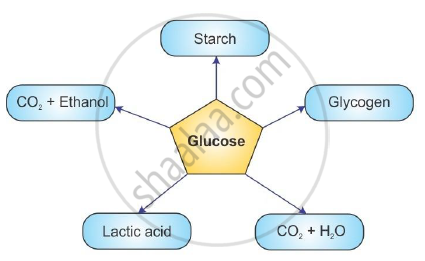Advertisements
Advertisements
Question
Give scientific reason.
Kreb's cycle is also known as citric acid cycle.
Solution
- Acetyl-CoA (2 carbon compound) enters the mitochondria to combine with oxaloacetic acid (4 carbon compound) and form a six-carbon compound i.e., citric acid.
- Since citric acid is the first stable compound formed, Krebs cycle is also called the citric acid cycle.
RELATED QUESTIONS
Given below are the end products of different reactions involving glucose. Write the appropriate end product in front of the following:

(1) Anaerobic reaction =
(2) Reaction in human muscles =
(3) Aerobic respiration
(4) Reaction in plant cells =
(5) Reaction in liver =
Name the life process of an organism that helps in the growth of its population.
Why is diffusion insufficient to meet the oxygen requirements of multi-cellular organisms like humans
What criteria do we use to decide whether something is alive?
What processes would you consider essential for maintaining life?
Which of the following type of energy is used by living organisms to perform vital life processes? Kinetic energy, Chemical energy, Potential energy, Nuclear energy
Match the organisms given in column I with the processes given in column II:
| Column I | Column II | ||
| (i) | Leech | (a) | Holozoic nutrition |
| (ii) | Amoeba | (b) | Autotrophic nutrition |
| (iii) | Mushroom | (c) | Parasitic nutrition |
| (iv) | Green plant | (d) | Saprophytic nutrition |
Match the terms in column I with those in column II :
| Column I | Column II | ||
| (i) | Trypsin | (a) | Liver |
| (ii) | Amylase | (b) | Gastric glands |
| (iii) | Bile | (c) | Pancreas |
| (iv) | Pepsin | (d) | Saliva |
A person lives near a forest. Make a list of four items which he can get from the forest to meet his daily needs.
Name the green dot like structures in some cells observed by a student when a leaf peel was viewed under a microscope. What is this green colour due to?
Skin : Keratin : : Blood : ____________
Rewrite the food-chain given below with correct sequence.
Grasshopper– Snake– Paddyfield– Eagle– Frog
Fill in the blank and explain the statement.
Our muscle cells perform ______ type of respiration during exercise.
Write the definition.
Proteins
Write definition.
Glycolysis
Give scientific reason.
Oxygen is necessary for complete oxidation of glucose.
Explain the glycolysis in detail.
Answer in detail.
How all the life processes contribute to the growth and development of the body?
Explain the ‘inhalation’.
Soil fertility is determined by its ability to :
Why is there a difference in the rate of breathing between aquatic organisms and terrestrial organisms? Explain.
What are the main energy sources of living organisms?
Choose the forms in which most plants absorb nitrogen
- Proteins
- Nitrates and Nitrites
- Urea
- Atmospheric nitrogen
How do the guard cells regulate opening and closing of stomatal pores?
Why do fishes die when taken out of water?
Match the terms in Column (A) with those in Column (B)
| Column (A) | Group (B) |
| (a) Trypsin | (i) Pancreas |
| (b) Amylase | (ii) Liver |
| (c) Bile | (iii) Gastric glands |
| (d) Pepsin | (iv) Saliva |
Explain the following concept in short:
Role of circulatory system in energy production
Give scientific reason.
Cell division is one of the important properties of cells and organisms.
Classify vitamins according to their solubility.
